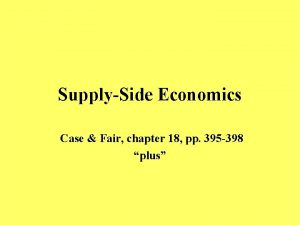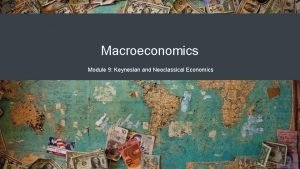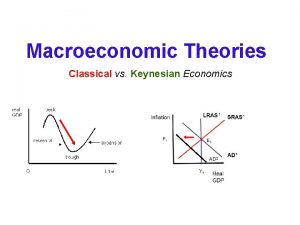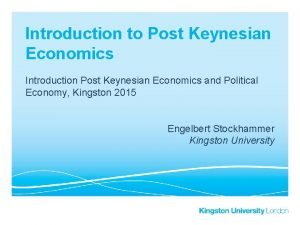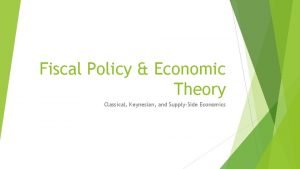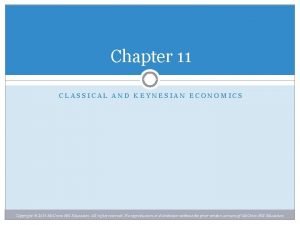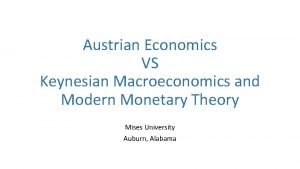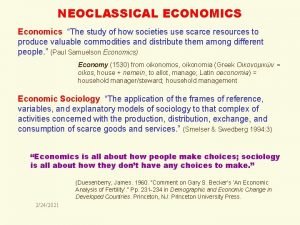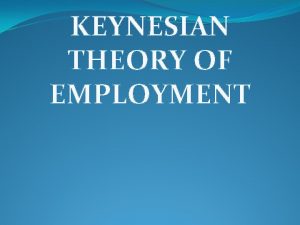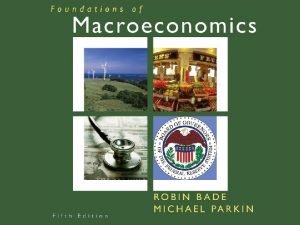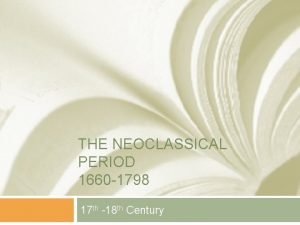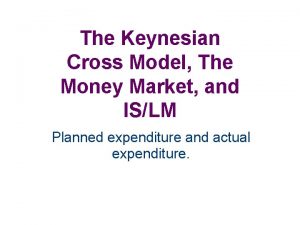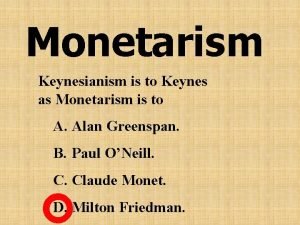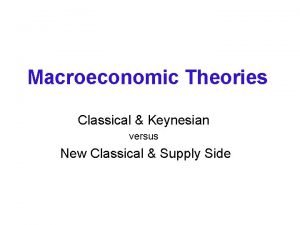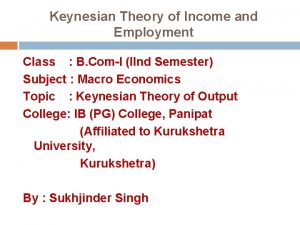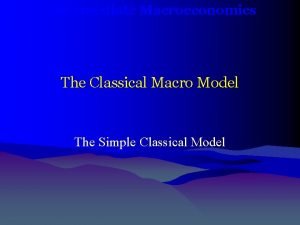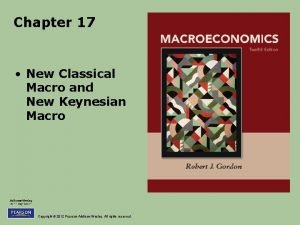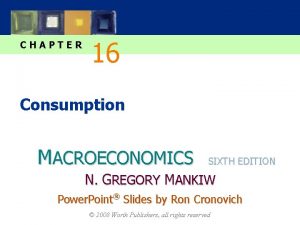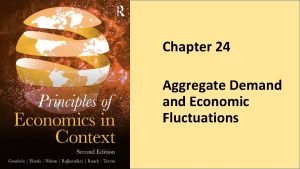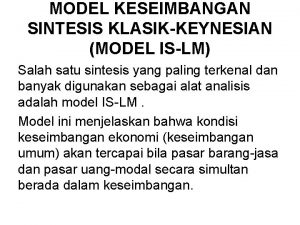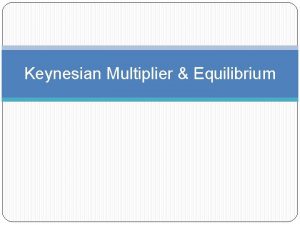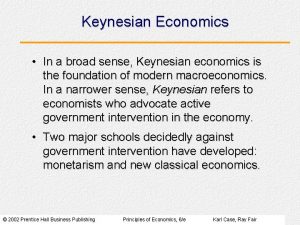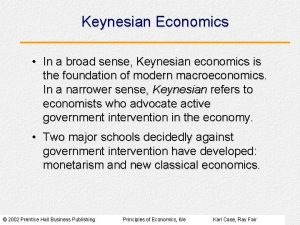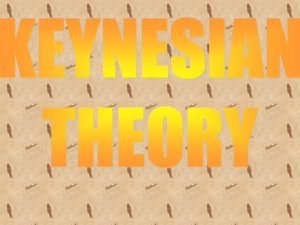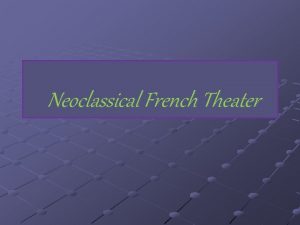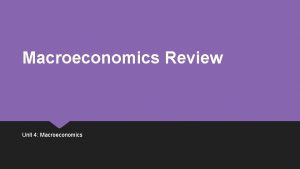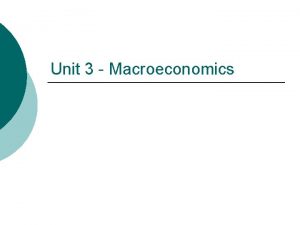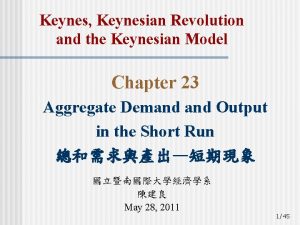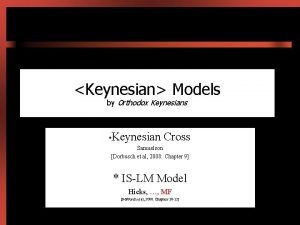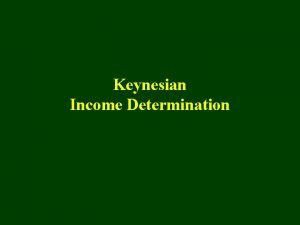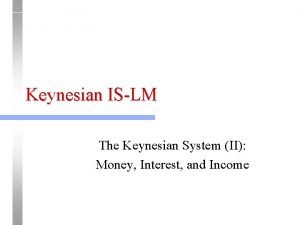Macroeconomics Module 9 Keynesian and Neoclassical Economics Keynesian


































- Slides: 34

Macroeconomics Module 9: Keynesian and Neoclassical Economics

Keynesian vs. Neoclassical Economics • • Keynesian Economics: emphasizes aggregate demand. • Keynes’ law: “Demand creates its own supply. ” • firms produce output only if they expect it to sell Neoclassical Economics: emphasizes aggregate supply. • Say’s Law: “Supply creates its own demand. ” • Or emphasizes a hands-off approach because of the belief the economy will correct itself in the long-run

Aggregate Demand in Keynesian Analysis • • The Keynesian perspective focuses on aggregate demand The idea is simple: firms produce output only if they expect it to sell • While the availability of the factors of production determines a nation’s potential GDP, the amount of goods and services actually being produced and sold, i. e. real GDP, depends on how much demand exists across the economy • Real GDP is determined only by aggregate demand, not aggregate supply

Aggregate Demand in Keynesian Analysis (cont. ) • Disposable income: income after taxes • Inflationary Gap: equilibrium at a level of output above potential GDP • Interest Rate: the payment for borrowed money • Recessionary Gap: equilibrium at a level of output below potential GDP

What Determines Consumption Expenditure? • Consumption expenditure is spending by households and individuals on durable goods, nondurable goods, and services • Keynes identified three factors that affect consumption: • Disposable income • Expected future income • Wealth or credit

What Determines Investment Expenditure? • Spending on new capital goods is called investment expenditure • Keynes’s treatment of investment focuses on the key role of expectations about the future in influencing business decisions • Expectations of future profits • Interest rates also play a significant role in determining how much investment a firm will make

Determinants of Aggregate Demand Reasons for a Decrease in Aggregate Demand Reasons for an Increase in Aggregate Demand • Consumption • Investment • • • Rise in taxes Fall in income Rise in interest Desire to save more Decrease in wealth Fall in future expected income • Fall in expected rate of return • Rise in interest rates • Drop in business confidence • • • Decrease in taxes Increase in income Fall in interest rates Desire to save less Rise in wealth Rise in future expected income • Rise in expected rate of return • Drop in interest rates • Rise in business confidence

Determinants of Aggregate Demand (cont. ) Reasons for a Decrease in Aggregate Demand Reasons for an Increase in Aggregate Demand • Government • Reduction in government spending • Increase in taxes • Net Exports • Decrease in foreign demand • Relative price increase of U. S. goods • Increase in government spending • Decrease in taxes • Net Exports • Increase in foreign demand • Relative price drop of U. S. goods

The Core of Keynesian Analysis • • • Coordination Argument: downward wage and price flexibility requires perfect information about the level of lower compensation acceptable to other laborers and market participants Expenditure Multiplier: Keynesian concept that asserts that a change in autonomous spending causes a more than proportionate change in real GDP Macroeconomic Externality: occurs when what happens at the macro level is different from and inferior to what happens at the micro level; an example would be where upward sloping supply curves for firms become a flat aggregate supply curve, illustrating that the price level cannot fall to stimulate aggregate demand Menu Costs: costs firms face in changing prices Sticky Wages and Prices: a situation where wages and prices do not fall in response to a decrease in demand, or do not rise in response to an increase in demand

The Building Blocks of Keynesian Analysis Keynesian economics focuses on explaining why recessions and depressions occur and offers a policy prescription for minimizing their effects. The Keynesian view of recession is based on two key building blocks: 1. First, aggregate demand is not always automatically high enough to provide firms with an incentive to hire enough workers to reach full employment. 2. Second, the macroeconomy may adjust only slowly to shifts in aggregate demand because of sticky wages and prices, which are wages and prices that do not respond quickly to decreases or increases in demand. We will consider these two claims in turn, and then see how they are represented in the AS–AD model.

Keynesian Assumptions in the AS-AD Model • • • The original equilibrium of this economy occurs where the aggregate demand function (AD 0) intersects with AS. Since this intersection occurs at potential GDP (Yp), the economy is operating at full employment. When aggregate demand shifts to the left, all the adjustment occurs through decreased real GDP. There is no decrease in the price level. Since the equilibrium occurs at Y 1, the economy experiences substantial unemployment.

The Expenditure Multiplier Effect • • Keynesians believe that the an small change in economic activity cycles repeatedly through the economy and has a larger impact than the initial dollar amount spent. A change in aggregate expenditures circles through the economy: households buy from firms, firms pay workers and suppliers, workers and suppliers buy goods from other firms, those firms pay their workers and suppliers, and so on

The Expenditure Multiplier Effect (cont. ) • • Expenditure (or Spending) Multiplier: the ratio of the change in GDP to the change in aggregate expenditure which caused the change in GDP; the multiplier has a value greater than one Marginal Propensity to Consume: percentage of an increase (or decrease) in income which one spends (or reduces spending); also known as the MPC Marginal Propensity to Import: percentage of an increase (or decrease) in income which one spends (or reduces spending) on imported Marginal Propensity to Save: percentage of an increase (or decrease) in income which one saves (or reduces saving); also known as the MPS

How Does the Expenditure Multiplier Work? • Table 1. Calculating the Multiplier Effect Original increase in aggregate expenditure from government spending 100 Save 10% of income. Spend 90% of income. Second-round increase of… 90 = 10 – 100 $90 of income to people through the economy: Save 10% of income. Spend 90% of income. Third-round increase of… 81 = 9 – 90 $81 of income to people through the economy: Save 10% of income. Spend 90% of income. Fourth-round increase of… 72. 10 = 8. 1 – 81 Table 1 works through the process of the multiplier. Over the first four rounds of aggregate expenditures, the impact of the original increase in government spending of $100 creates a rise in aggregate expenditures of $100 + $90 + $81 + $72. 10 = $343. 10, which is larger than the initial increase in spending. And the process isn’t finished yet.

Keynesian Economic Policy • • • Contractionary Fiscal Policy: efforts to decrease aggregate demand through tax increases or government spending cuts Expansionary fiscal policy: efforts to increase aggregate demand through means such as tax cuts to stimulate consumption and investment, or direct increases in government spending GDP Gap: the difference between actual and potential real GDP; during recessions the gap grows; during booms the gap becomes negative

The GDP Gap • • • The GDP gap is defined as the difference between potential GDP and actual GDP, when both are measured in real terms When the economy falls into recession, the GDP gap is positive, meaning the economy is operating at less than potential When the economy experiences an inflationary boom, the GDP gap is negative, meaning the economy is operating at greater than potential

The Neoclassical Perspective • Classical Economics: earliest of a number of neoclassical perspectives • Neoclassicals Economics: any of a number of economic perspectives that believes that the macro economy is inherently stable and that government should not attempt to manage the economy • Say’s Law: fundamental belief of classical economics that “supply creates its own demand”

What is Neoclassical Economics? • • • Keynesian Economics: • Positive characteristic: that the macro economy is inherently unstable • Normative characteristic: that since the private economy can’t be counted on to keep the economy at potential GDP and full employment, government has a responsibility to step in to do so. Neoclassical Economics: • Positive characteristic: the macroeconomy is inherently stable, i. e. , that any divergences from potential GDP and full employment are temporary • Normative characteristic: government should take a laissez-faire, or hands-off, perspective and should not attempt to actively manage the macro economy. There a number of schools of thought that can be included under the Neoclassical perspective • Traditional classical economics • Monetarist economics • Supply-side economics (Reaganomics)

Say’s Law and the Neoclassical Perspective • • As the name “neoclassical” implies, this perspective of how the macroeconomy works is a “new” view of the “old” classical model of the economy Say’s Law is a good explanation of the logic behind classical (and neoclassical) economics “Supply creates its own demand. ” Each time output is produced and sold, the revenues represent an equivalent amount of income generated

The Neoclassical Perspective and Potential GDP • • • Human Capital: education, training and skills possessed by workers that make them more productive Natural Rate of Unemployment: Rate that unemployment returns to in the long run, where there is no cyclical unemployment Neoclassical Perspective: belief that the level of economic activity is determined primarily by aggregate supply Physical Capital per Person: the amount and kind of machinery and equipment available to help a person produce a good or service Potential GDP: level of output that can be achieved when all resources (land, labor, capital, and entrepreneurial ability) are fully employed

The Neoclassical Perspective. The neoclassical perspective on macroeconomics is based on two building blocks (or assumptions): 1. Since in the long run, the economy will fluctuate around its potential GDP and its natural rate of unemployment, the size of the economy is determined by potential GDP. 2. Wages and prices will adjust in a flexible manner so that disturbances such as recessions will be temporary and the economy will always return to its potential level of output on its own.

The Neoclassical Aggregate Supply Curve • • • In the aggregate demand-aggregate supply model, potential GDP is shown as a vertical line Neoclassical economists argue that the long-run aggregate supply curve is located at potential GDP Vertical LRAS curve means that the level of aggregate supply (or potential GDP) will determine the real GDP of the economy

The Role of Flexible Prices • • How does the macroeconomy adjust back to its level of potential GDP in the long run? What if aggregate demand increases or decreases? The neoclassical view of how the macroeconomy adjusts is based on the insight that even if wages and prices are “sticky”, or slow to change In the short run, they are flexible over time

Speed of Macroeconomic Adjustment • Adaptive Expectations: theory that people look at past experience and gradually adapt their beliefs and behavior as circumstances change • Rational Expectations: theory that people form the most accurate possible expectations about the future that they can, using all information available to them

Speed of Macroeconomic Adjustment (cont. ) • Keynesian economists argue that if the adjustment from recession to potential GDP takes a very long time, then neoclassical theory may be more hypothetical than practical. • • John Maynard Keynes: “In the long run we are all dead. ” Because of rational expectations, prices do not wait on events, but adjust immediately.

Policy Prescriptions of the Neoclassical Perspective • The policy prescriptions of neoclassical economics are very simple • Because of flexible prices and wages, any divergence from potential output and full employment is self-correcting • Neoclassical economists do not believe in “fine-tuning” the economy • They believe that economic growth is fostered by a stable economic environment with a low rate of inflation

Say’s Law versus Keynes’ Law • Keynes’ Law: “demand creates its own supply” • Say’s Law: “supply creates its own demand”

Comparing Neoclassical and Keynesian Economics Table 1. Comparing Neoclassical and Keynesian Economics Summary Neoclassical Economics Keynesian Economics Focus: long-term or short term Long-term Short-term Prices and wages: sticky or flexible? Flexible Sticky Economic output: Primarily determined by aggregate demand or aggregate supply? Aggregate supply Aggregate demand Aggregate supply: vertical or upwardsloping? Vertical Upward-sloping Phillips curve vertical or downward-sloping Vertical Downward sloping Is aggregate demand a useful tool for controlling inflation? Yes What should be the primary area of policy emphasis for reducing unemployment? Reform labor market institutions to reduce natural rate of unemployment Increase aggregate demand to eliminate cyclical unemployment Is aggregate demand a useful tool for ending recession? At best, only in the short-run temporary sense, but may just increase inflation instead Yes

Neoclassical and Keynesian Perspectives in the AD-AS Model • Intermediate Zone: portion of the SRAS curve where GDP is below potential but not so far below as in the Keynesian zone; the SRAS curve is upward-sloping, but not vertical in the intermediate zone • Keynesian Zone: portion of the SRAS curve where GDP is far below potential and the SRAS curve is flat • Neoclassical Zone: portion of the SRAS curve where GDP is at or near potential output where the SRAS curve is steep

Neoclassical and Keynesian Perspectives in the AD-AS Model (cont. ) Three Zones 1. Keynesian Zone 2. Neoclassical Zone 3. Intermediate Zone

Balancing Keynesian and Neoclassical Models • • • The short-term Keynesian model, built on the importance of aggregate demand as a cause of business cycles and a degree of wage and price rigidity Keynesian economics risks overlooking the long-term causes of economic growth or the natural rate of unemployment that exists even when the economy is producing at potential GDP The neoclassical model, with its emphasis on aggregate supply, focuses on the underlying determinants of output and employment in markets

Quick Review • • How do aggregate demand, recessionary gaps, and inflationary gaps apply to Keynesian analysis? What are the Keynesian viewpoints on the determinants of consumption expenditure and investment expenditure? What is the Keynesian perspective on factors that determine government spending and net exports? What is the Keynesian view of recessions? How are sticky wages, prices, and aggregate demand connected to this? Explain the coordination argument, menu costs, and macroeconomic externalities as they relate to Keynesian economics. What is the expenditure multiplier effect? How do you compute the size of the expenditure multiplier?

More Quick Review • • How would you describe the GDP gap? Explain the Keynesian logic for expansionary and contractionary fiscal policy for reducing unemployment and inflation What are the basic tenets of the neoclassical perspective? What is Say’s Law? What is the importance of potential GDP in the long run to the neoclassical perspective? What is the shape and reasoning for the pure neoclassical aggregate supply curve? What are the roles of flexible prices in the neoclassical model? Describe and show the AD-AS curve fluctuates according to the neoclassical model.

More Quick Review • • Explain how the neoclassical ideas of rational expectations and adaptive expectations may contribute to a faster speed of macroeconomic adjustment What are the policy prescriptions of neoclassical economics? What is the difference between the ways that Say’s Law and Keynes’ Law explain economic behavior? Why does the neoclassical zone of the AS curve illustrate Say’s Law? Why does the Keynesian zone of the AS curve illustrate Keynesian’ Law? Why does the Intermediate zone illustrate a blend of Say’s and Keynes’ Laws? What are the strengths and weaknesses of the Keynesian and neoclassical models?
 New classical macroeconomics
New classical macroeconomics New classical and new keynesian macroeconomics
New classical and new keynesian macroeconomics Supply vs demand side economics
Supply vs demand side economics Keynesian vs classical
Keynesian vs classical Classical economics vs keynesian
Classical economics vs keynesian Classical economics vs keynesian
Classical economics vs keynesian Keynesian economics policy
Keynesian economics policy Keynesian view
Keynesian view Austrian economics vs keynesian
Austrian economics vs keynesian Neoclassical economics
Neoclassical economics Branch of economics
Branch of economics Maastricht university school of business and economics
Maastricht university school of business and economics Classical theory vs keynesian theory
Classical theory vs keynesian theory Classical keynesian and monetarist
Classical keynesian and monetarist Elements of mathematical economics
Elements of mathematical economics Ap economics module 1
Ap economics module 1 C device module module 1
C device module module 1 Cavalier poetry definition
Cavalier poetry definition Neoclassical organization theory
Neoclassical organization theory The early schools of criminology and modern counterparts
The early schools of criminology and modern counterparts Neoclassical theory criminology
Neoclassical theory criminology Renaissance vs neoclassicism
Renaissance vs neoclassicism How is romanticism different from neoclassicism
How is romanticism different from neoclassicism Keynesian cross
Keynesian cross Keynesian cross
Keynesian cross Keynesianism
Keynesianism Monetarist vs classical economics
Monetarist vs classical economics Explain the keynesian theory of employment
Explain the keynesian theory of employment Keynesian consumption function
Keynesian consumption function Keynesian vs classical vs monetarist
Keynesian vs classical vs monetarist Keynesian consumption function
Keynesian consumption function Keynesian model
Keynesian model Keynesian model
Keynesian model Model islm
Model islm Venn diagram
Venn diagram


